

Lunner Church (Norwegian : Lunner kirke) is a medieval era stone church in Lunner municipality of Akershus county, Norway. The church dates from the 12th century. It is located on the hill of Lunnertoppen in the traditional district of Hadeland. [1]


Lunner Church (Norwegian : Lunner kirke) is a medieval era stone church in Lunner municipality of Akershus county, Norway. The church dates from the 12th century. It is located on the hill of Lunnertoppen in the traditional district of Hadeland. [1]
Lunner Church was originally a long Romanesque church with a circular stone tower at the west side. Sometime between 1780 and 1790, the tower was dismantled and the church rebuilt into a cruciform church. The newer parts in wood underwent restoration work in 1987 and 1988. An archaeological excavation was carried out and the circular base of the old tower was recorded and left open for public display. Lunner Church is the only known circular church tower in Norway. Over the circular base of the tower a new floor of glass was made so visitors of the church now can see this remarkable construction. [2]
The medieval church now constitutes the choir of today's church. The medieval parts of the church have still not gone through restoration. On the outside the medieval part of the church has nine stone reliefs. These ornaments depict humans and animals, probably battling for human souls. The ornaments are located on the southern and eastbound walls and on the sacristy. [3]

Lunner is a municipality in Akershus county, Norway. It is part of the traditional region of Hadeland. The administrative centre of the municipality is the village of Roa. Lunner was established when it was separated from the municipality of Jevnaker on 1 January 1898. From 1 January 2020 the municipality belongs to Viken county, it was Oppland before that.

is a municipality in Innlandet county, Norway. It is located in the traditional district of Hadeland. The administrative centre of the municipality is the village of Jaren. Other villages in Gran include Bjoneroa, Brandbu, Egge, Gran, and Ringstad.

Hadeland is a traditional district in the southeastern part of Norway. It is centered on the southern part of the large lake Randsfjorden in Innlandet and Akershus counties. The district consists of the municipalities Gran in Innlandet county and Jevnaker and Lunner in Akershus county. Hadeland occupies the area north of the hills of Nordmarka close to the Norwegian capital Oslo. The soil around the Randsfjorden is amongst the most fertile in Norway. Hadeland accounts for just 5% of the country's area, but it represents 13% of its agricultural land. Farmers harvest grains and potatoes. Pigs, dairy cattle, and horses are also bred at farms there.
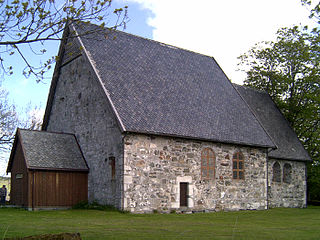
Logtun Church is a historic, medieval parish church of the Church of Norway in Frosta municipality in Trøndelag county, Norway. It is located in the village of Logtun. It is one of the churches for the Frosta parish which is part of the Stiklestad prosti (deanery) in the Diocese of Nidaros. It is a museum and historic cultural site that was gifted from the parish to the Society for the Preservation of Ancient Norwegian Monuments. The stone church was built in a long church style during the late 12th century by an unknown architect. The church was the main church for the parish of Frosta until the new Frosta Church was built nearby in 1866. After that, the church was not regularly used. During the 1950s, the church was restored and it is now used infrequently as a wedding venue and it holds some summer worship services.
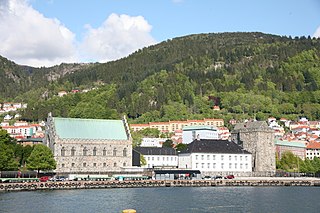
Bergenhus fortress is a fortress located in Bergen, Norway. Located at the entrance of Bergen harbour, the castle is one of the oldest and best preserved stone fortifications in Norway.
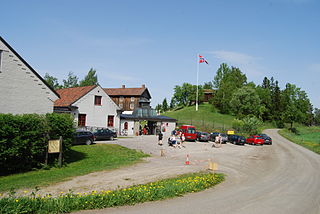
Hadeland Folkemuseum is a regional museum for Hadeland in southeastern Norway. It was founded in 1913, and is located in Tingelstad in Gran. The museum is situated along Kongevegen, the road from Oslo to Bergen which passes through Hadeland. Hadeland Folkemuseum is a subsidiary of Randsfjordmuseene, a regional institution which also manages Lands Museum and the Kittilbu Open-Air Museum in Vestre Gausdal.

Lands Museum is the cultural and natural history centre for Nordre and Søndre Land municipalities in Innlandet county, Norway.
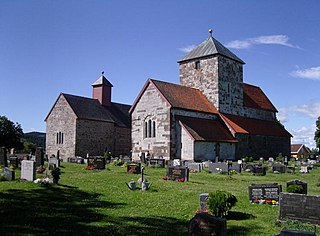
The Sister Churches consist of two 12th-century churches that were built right next to each other in Gran Municipality in Innlandet county, Norway. They are part of the Church of Norway and are located in the village of Granavollen. They are part of the Gran/Tingelstad parish which is part of the Hadeland og Land prosti (deanery) in the Diocese of Hamar.

Norderhov is a former municipality located within Ringerike in Buskerud county, Norway.

Selbu Church is a parish church of the Church of Norway in Selbu municipality in Trøndelag county, Norway. It is located in the village of Mebonden. It is one of the churches for the Selbu parish which is part of the Stjørdal prosti (deanery) in the Diocese of Nidaros. The church seats about 550 people. The white, stone church was built in a cruciform style around the year 1150 under designs by an unknown architect.

Vår Frue Church is a medieval parish church of the Church of Norway in Trondheim municipality in Trøndelag county, Norway. It is located in the downtown Midtbyen area of the city of Trondheim, just a few blocks north of the Nidaros Cathedral. It is one of the two churches for the Nidaros og Vår Frue parish which is part of the Nidaros domprosti (arch-deanery) in the Diocese of Nidaros. The gray, stone church was built in a long church design in the late 1100s using plans drawn up by Bjørn Sigvardsson. The church seats about 540 people.

Mære Church is a parish church of the Church of Norway in Steinkjer municipality in Trøndelag county, Norway. It is located in the village of Mære. It is the church for the Mære parish which is part of the Stiklestad prosti (deanery) in the Diocese of Nidaros of the Church of Norway. The white, plastered stone church was built in a long church style during the 12th century using plans drawn up by an unknown architect. The church seats about 310 people.
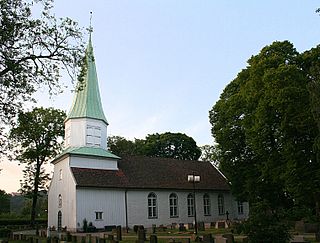
Oddernes Church is a parish church of the Church of Norway in Kristiansand Municipality in Agder county, Norway. It is located in the district of Lund in the borough of Lund in the city of Kristiansand. It is one of the churches for the Oddernes parish which is part of the Kristiansand domprosti (arch-deanery) in the Diocese of Agder og Telemark. The white, stone church was built in a long church design around the year 1040 using plans drawn up by unknown architect. This makes it the oldest building in the city of Kristiansand. The church seats about 395 people.
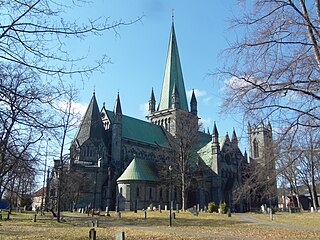
Church building in Norway began when Christianity was established there around the year 1000. The first buildings may have been post churches erected in the 10th or 11th century, but the evidence is inconclusive. For instance under Urnes Stave Church and Lom Stave Church there are traces of older post churches. Post churches were later replaced by the more durable stave churches. About 1,300 churches were built during the 12th and 13th centuries in what was Norway's first building boom. A total of about 3,000 churches have been built in Norway, although nearly half of them have perished. From 1620 systematic records and accounts were kept although sources prior to 1620 are fragmented. Evidence about early and medieval churches is partly archaeological. The "long church" is the most common type of church in Norway. There are about 1620 buildings recognized as churches affiliated with the Church of Norway. In addition, there are a number of gospel halls belonging to the lay movement affiliated with the Church of Norway as well as churches belonging to other Christian bodies. Until the 20th century, most churches were built from wood. 220 buildings are protected by law, and an additional 765 are listed as valuable cultural heritage.

Eidsberg Church is a parish church located at Eidsberg in Østfold county, Norway. The Church is located down to the river Glomma by the side of the County Road 124. Eidsberg Church is associated with the Østre Borgesyssel deanery of the Diocese of Borg.

Tromøy Church is a parish church of the Church of Norway in Arendal Municipality in Agder county, Norway. It is located in the village of Brekka on the east coast of the island of Tromøy. It is one of the churches for the Tromøy parish which is part of the Arendal prosti (deanery) in the Diocese of Agder og Telemark. The white, stone church was built around the year 1150 using plans drawn up by an unknown architect. The church seats about 290 people. This was the main church for the municipality of Tromøy from 1878 until its dissolution in 1992.

Nes Church is a parish church of the Church of Norway in Gran Municipality in Innlandet county, Norway. It is located in the village of Røykenvik. It is the church for the Brandbu parish which is part of the Hadeland og Land prosti (deanery) in the Diocese of Hamar. The white, wooden church was built in a cruciform design in 1730 using plans drawn up by an unknown architect. The church seats about 280 people.
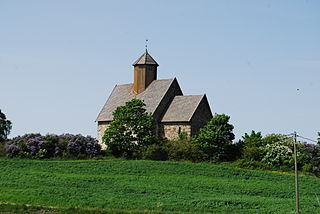
Old Tingelstad Church is a former parish church of the Church of Norway in Gran Municipality in Innlandet county, Norway. It is located in the village of Tingelstad. It is part of the Gran/Tingelstad parish which is part of the Hadeland og Land prosti (deanery) in the Diocese of Hamar. The gray, stone church was built in a long church design around the year 1220 using plans drawn up by an unknown architect. The church seats about 110 people.

Hurum Church is a medieval stone church in Hurum, Norway. It was constructed in the 12th century. The church was damaged by fire in 1686, and rebuilt with a baroque interior. Next to the church, the Huitfeldt-family built a wooden funeral chapel in the second half of the 17th century. A new stone chapel was built in 1750, and contains the remains of the naval commander Iver Huitfeldt.